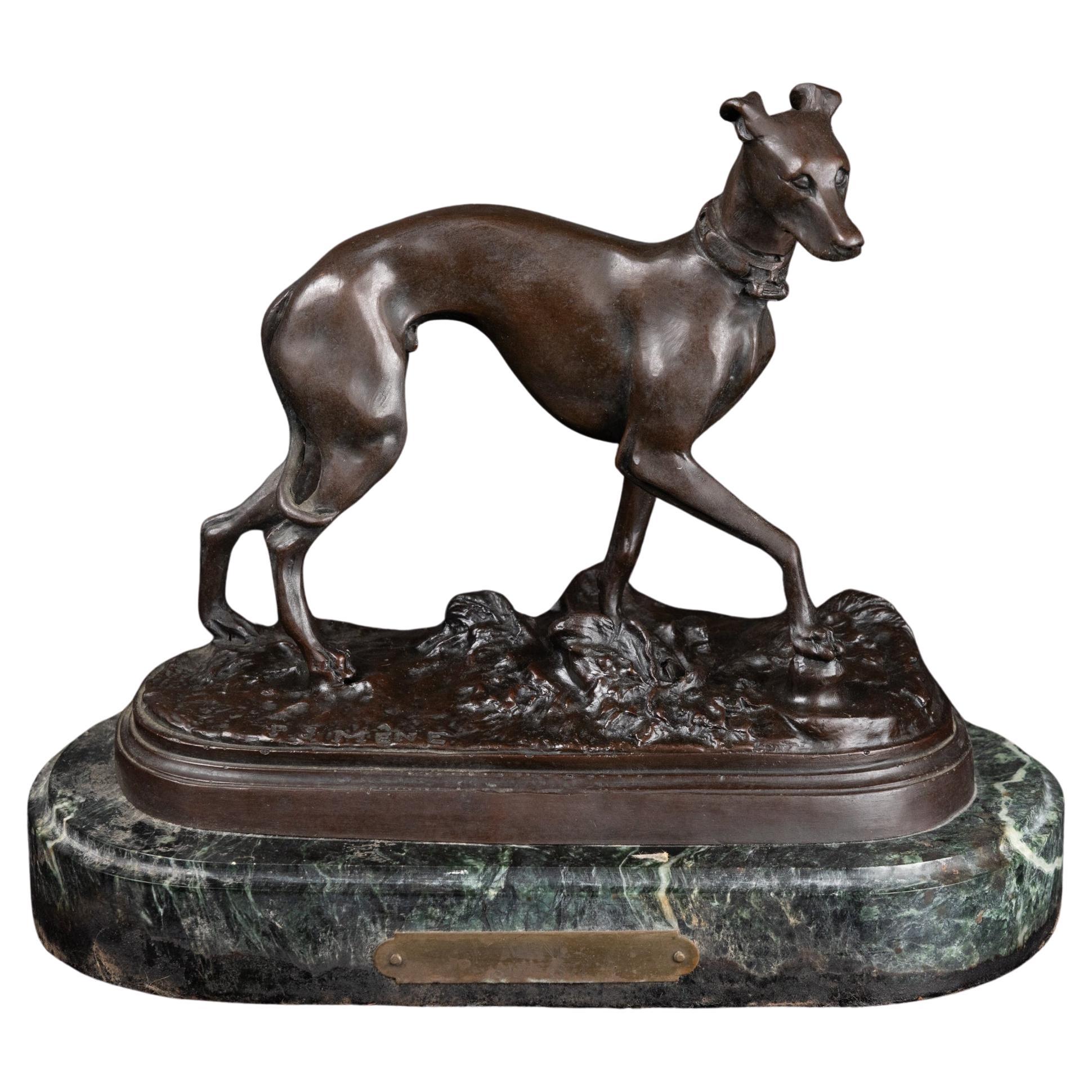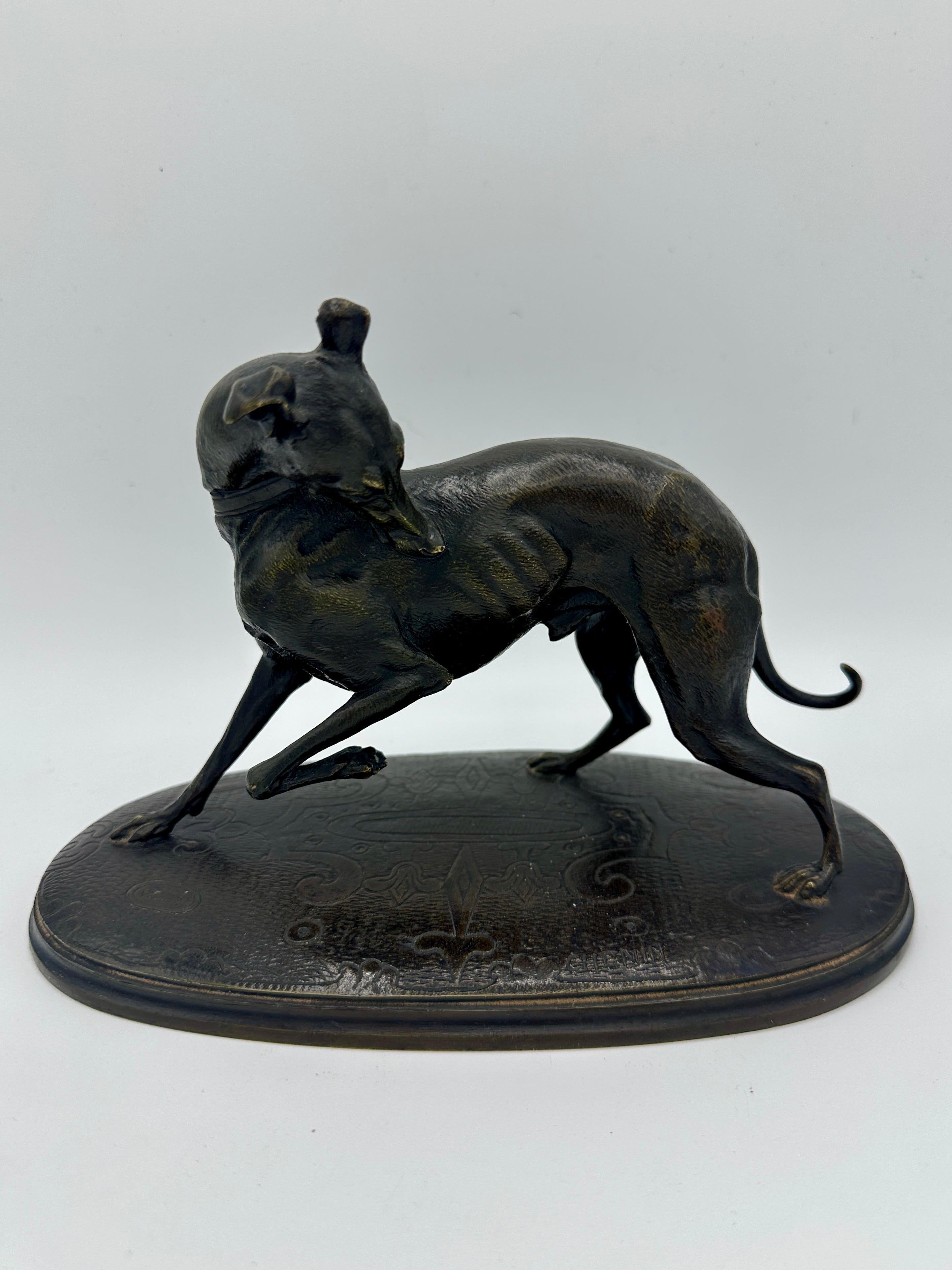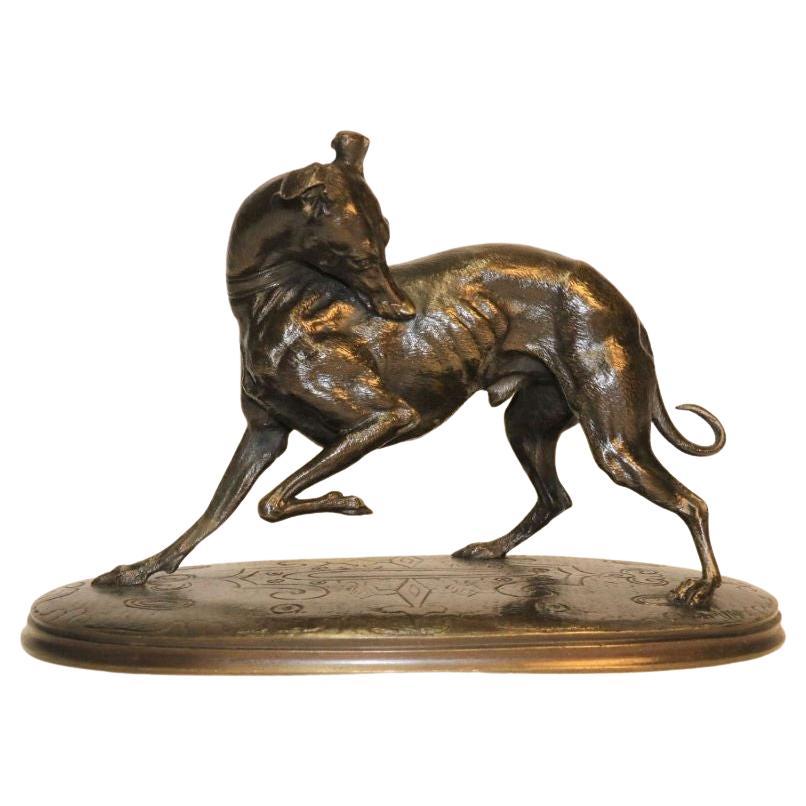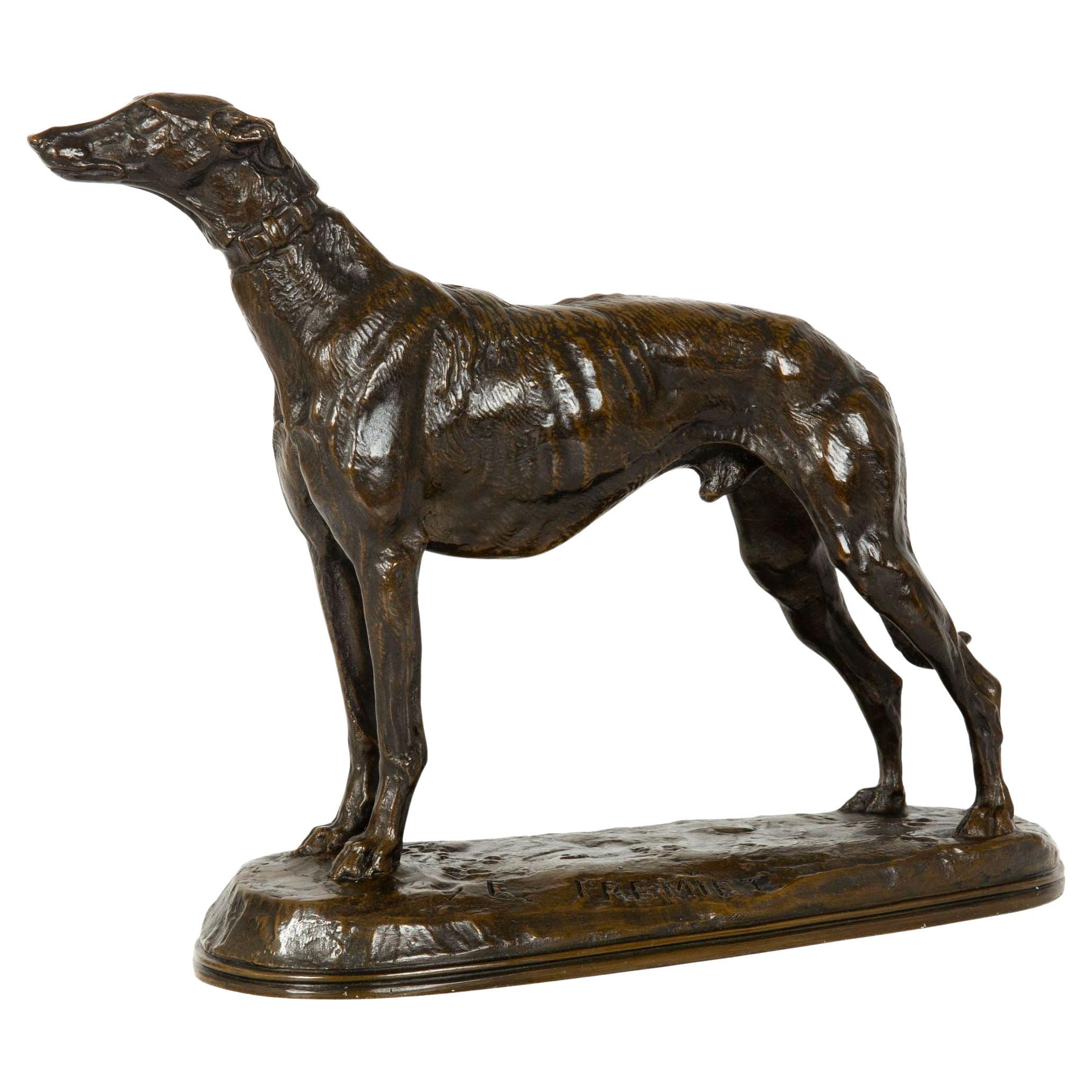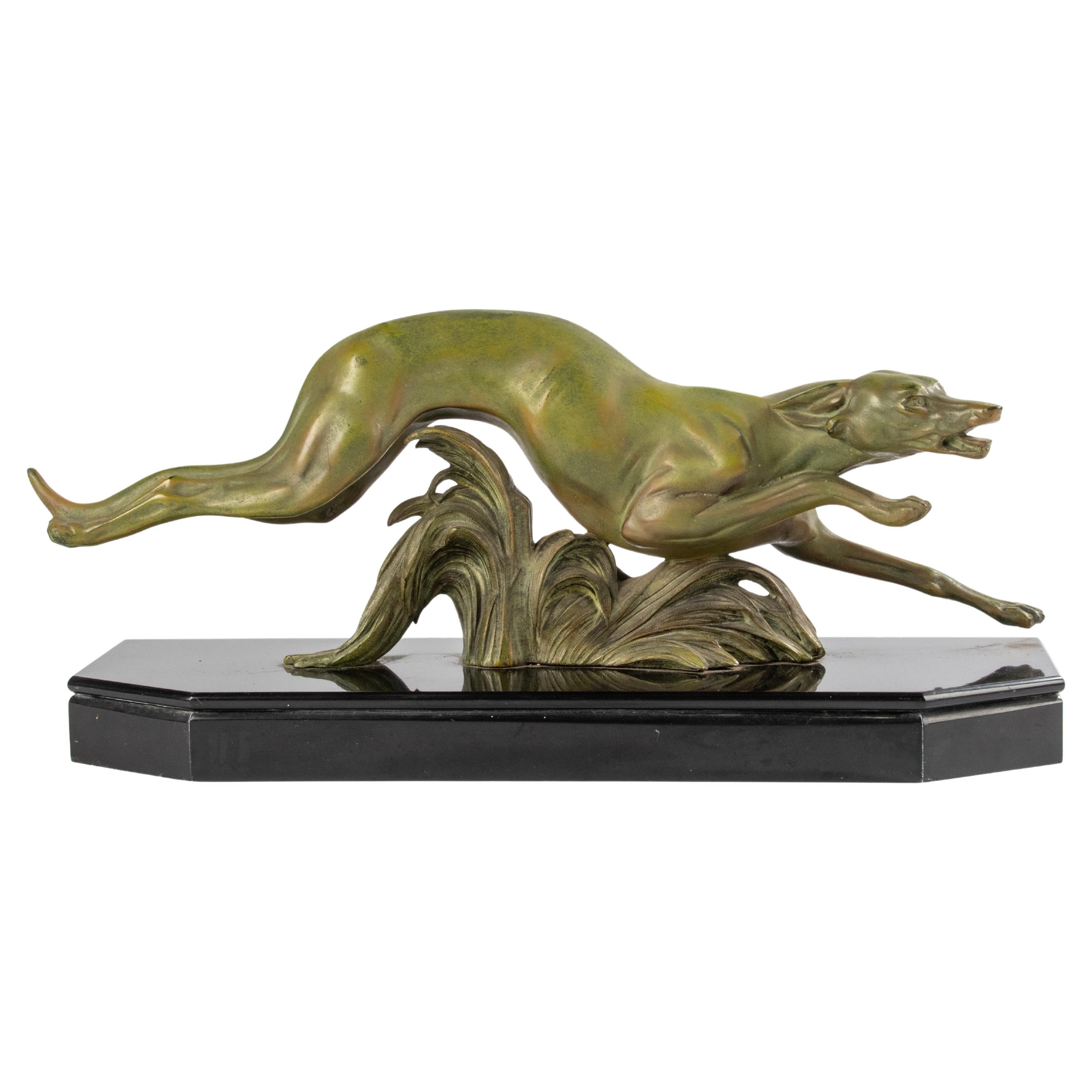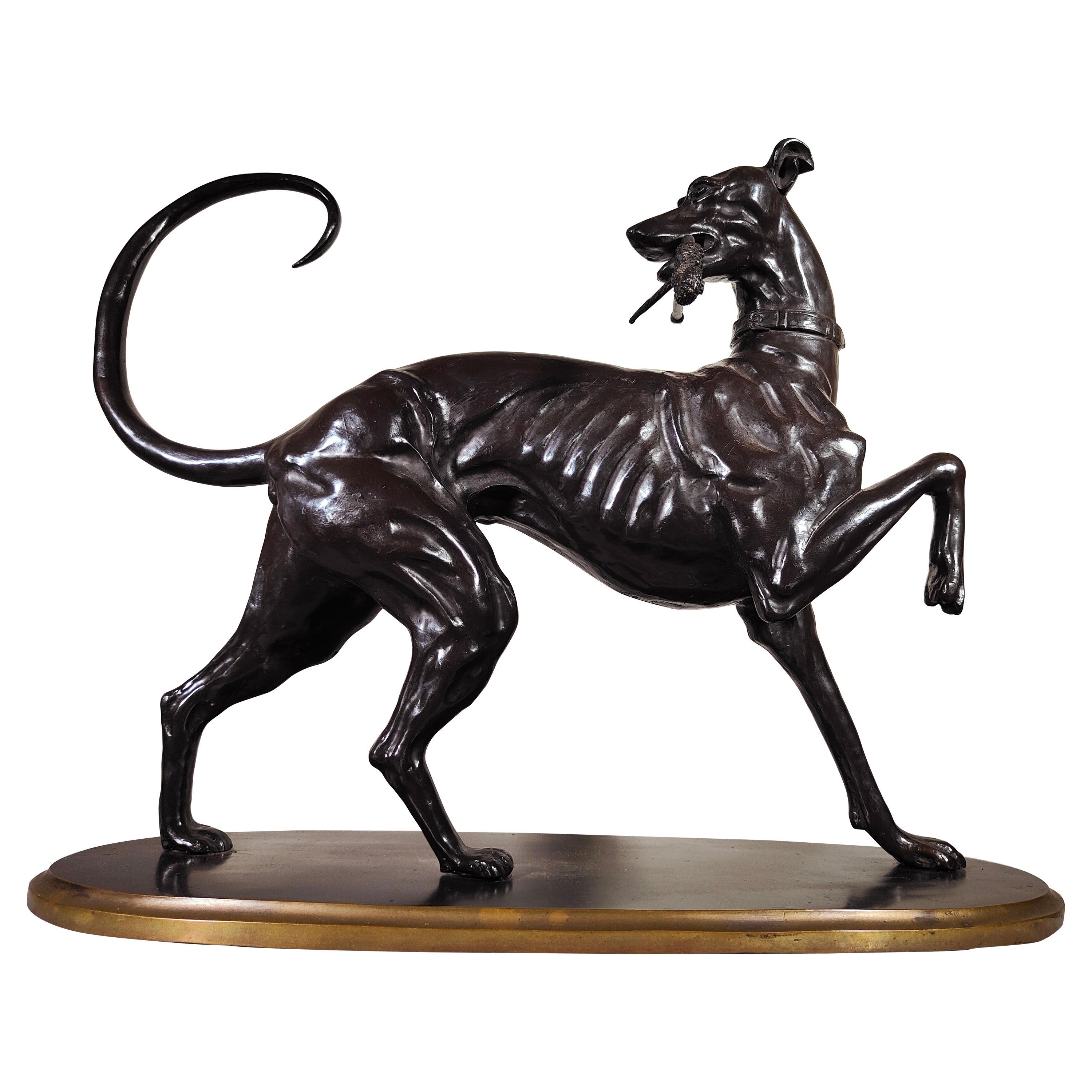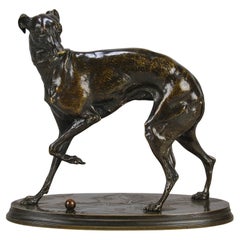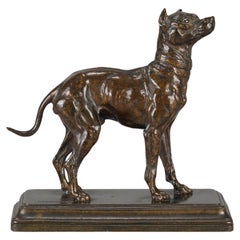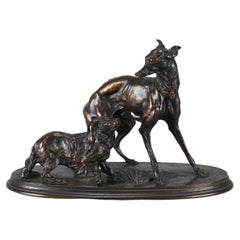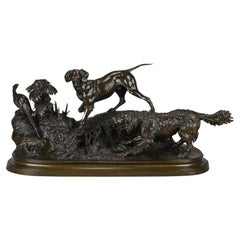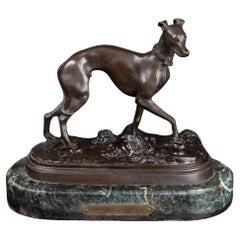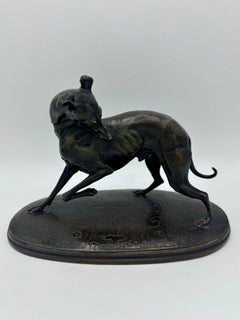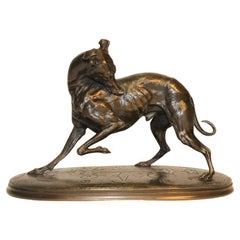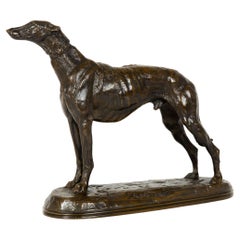Items Similar to Late-19th Century French Animalier Bronze Entitled "Turning Whippet" by L Mayer
Want more images or videos?
Request additional images or videos from the seller
1 of 11
Late-19th Century French Animalier Bronze Entitled "Turning Whippet" by L Mayer
$4,383.04
£3,200
€3,761.23
CA$6,051.38
A$6,708.85
CHF 3,525.76
MX$82,105.36
NOK 44,033.21
SEK 41,329.57
DKK 28,075.28
About the Item
Delightful late19th century French Animaliers bronze study of a turning whippet looking around in an attitude to play, with rich brown colour and fine hand chased surface detail. Signed L Mayer and raised on an oval rouge griotte marble plinth.
Additional information
Height: 17 cm
Width: 22 cm
Condition: Excellent Original Condition
Circa: 1880
Materials: Bronze
About
Animaliers sculpture
Although many earlier examples can be found, animalier sculpture became more popular, and reputable, in early 19th century Paris with the works of Antoine-Louis Barye (1795–1875) for whom the term was coined and who became the ‘Father of the Animaliers School’ and Pierre Jules Mêne considered the finest realist sculptor of the era. By the mid-century, a taste for animal subjects was very widespread among all sections of society.
- Creator:Louis Mayer (Artist)
- Dimensions:Height: 6.7 in (17 cm)Width: 8.67 in (22 cm)Depth: 0 in (0.01 mm)
- Style:Art Nouveau (Of the Period)
- Materials and Techniques:
- Place of Origin:
- Period:
- Date of Manufacture:1880
- Condition:Wear consistent with age and use. Excellent. Excellent Original Condition Please note that our items are genuine antiques with considerable age. It is therefore normal that they will show some signs of wear and handling to the surface.
- Seller Location:London, GB
- Reference Number:Seller: 82131stDibs: LU3216328990522
About the Seller
5.0
Vetted Professional Seller
Every seller passes strict standards for authenticity and reliability
Established in 1936
1stDibs seller since 2017
84 sales on 1stDibs
Typical response time: <1 hour
- ShippingRetrieving quote...Shipping from: London, United Kingdom
- Return Policy
Authenticity Guarantee
In the unlikely event there’s an issue with an item’s authenticity, contact us within 1 year for a full refund. DetailsMoney-Back Guarantee
If your item is not as described, is damaged in transit, or does not arrive, contact us within 7 days for a full refund. Details24-Hour Cancellation
You have a 24-hour grace period in which to reconsider your purchase, with no questions asked.Vetted Professional Sellers
Our world-class sellers must adhere to strict standards for service and quality, maintaining the integrity of our listings.Price-Match Guarantee
If you find that a seller listed the same item for a lower price elsewhere, we’ll match it.Trusted Global Delivery
Our best-in-class carrier network provides specialized shipping options worldwide, including custom delivery.More From This Seller
View AllMid 19th Century Animalier Bronze Sculpture entitled "Jiji" by P J Mêne
By Pierre Jules Mêne
Located in London, GB
Delightful mid 19th Century French Animaliers bronze study of a playful Whippet looking around in an attitude to play with a ball at her feet, with rich brown rubbed to a golden colo...
Category
Antique Mid-19th Century French Art Nouveau Animal Sculptures
Materials
Bronze
Late 19th Century Animalier Sculpture entitled "Terrier" by Alfred Dubucand
By Alfred Dubucand
Located in London, GB
A wonderful late 19th Century Animalier bronze study of a standing terrier with its head raised and ears pricked in an alert position with excellent rich brown autumnal patina and fine hand chased surface detail, signed Dubucand
ADDITIONAL INFORMATION
Height: 11 cm
Condition: Excellent Original Condition
Circa: 1880
Materials: Bronze
Book reference: Animals in Bronze by Christopher Payne
SKU: 9206
ABOUT
Dubucand Terrier
Alfred Dubucand (25 November 1828 – 1894) Dubucand was born in Paris and was a French animalier sculptor of the 19th century. His works were often entered into the annual Salon art exhibition in Paris where he contributed works over the course of his career. He was one of the prize pupils of Antoine-Louis Barye. Dubucand made his debut at the 1867 Salon with a wax model of a dead pheasant, a rather inauspicious start when considering the higher quality sculptures he would submit later in his career. He modelled mainly animal groups, producing a number of deer, dog, and horse sculptures. His better casts feature a warm, mid-brown patination, sometimes coming in even lighter shades bordering on a very light yellow, being nearly the colour of the bronze metal itself. He frequently experimented with chemical patinas, learning the patination process from his teacher and mentor Barye who stretched the boundary with his now famous dark green patinas. Dubucand paid strict attention to the anatomical detail of his subjects, often being so concise that he actually showed the veins in the legs of his deer and elk...
Category
Antique Early 19th Century French Art Nouveau Animal Sculptures
Materials
Bronze
Anamilier Bronze Entitled "Greyhound and King Charles Spaniel" by P J Mêne
By Pierre Jules Mêne
Located in London, GB
Delightful mid 19th Century French Animaliers bronze study of a playful Greyhound and King Charles Spaniel, with rich brown rubbed to a golden colour and fine hand chased surface det...
Category
Antique 1870s Art Nouveau Animal Sculptures
Materials
Bronze
19th Century Animalier Bronze entitled "Chiens de Chasse" by Ferdinand Pautrot
By Ferdinand Pautrot
Located in London, GB
An excellent late 19th Century French Animalier bronze group of a setter and pointer trying to flush out a pheasant with excellent rich brown patina and very fine hand chased surfac...
Category
Antique Mid-19th Century French Art Nouveau Figurative Sculptures
Materials
Bronze
19th Century Animalier Bronze Sculpture entitled "Medor" by Pierre Jules Mene
By Pierre Jules Mêne
Located in London, GB
An excellent mid 19th Century Animalier bronze study of a setter in an alert turning pose with very fine rich brown patina and intricate hand chased surface detail, raised on natural...
Category
Antique Late 19th Century French Art Nouveau Animal Sculptures
Materials
Bronze
Late 19th Century Animalier Bronze entitled "Hound Family" by Alfred Jacquement
Located in London, GB
A charming late 19th Century French animalier bronze group of a family of hounds. The bronze of three seated dogs including a mother, father and pup exhibiting excellent rich brown p...
Category
Antique Late 19th Century French Art Nouveau Animal Sculptures
Materials
Bronze
You May Also Like
French 19th Century Bronze of a Whippet Dog, Signed ‘P. J. Mene’
Located in New Orleans, LA
French 19th century bronze statue of a dog, whippet bread, signed P. J. Mene, mounted on a thick oval marble base with plaque reading, Mene - 1810 - 1874. Pierre Jules Mene, or ...
Category
Antique 19th Century French Figurative Sculptures
Materials
Bronze
A 19th century French animalier bronze of a greyhound
By Joseph Francois Victor Chemin
Located in Bath, Somerset
A late 19th century bronze figure of a greyhound, his front leg raised and head turned backwards as he grooms his coat. A finely detailed figure with a dark brown patina, mounted on ...
Category
Late 19th Century French School Figurative Sculptures
Materials
Bronze
19th century bronze study of a grey hound, by Joseph Chemin circa 1860
Located in Central England, GB
A 19th Century Bronze Study of a Grey Hound, by Joseph Chemin
This splendid mid 19th century bronze study was sculpted by the noted French artist Joseph Vi...
Category
Antique 19th Century French Animal Sculptures
Materials
Bronze
French Antique Bronze Sculpture “Standing Greyhound” by Emmanuel Fremiet
By Emmanuel Fremiet
Located in Shippensburg, PA
EMMANUEL FREMIET
French, 1824-1910
"Chien Levrier"
Patinated bronze signed E. Fremiet in naturalistic base cold-stamped 85, a Charles More cast
Item # 411PRB18X
An exquisite mo...
Category
Antique 19th Century French Romantic Animal Sculptures
Materials
Bronze
Art Deco Period Patinated Spelter Sculpture Whippet / Greyhound Dog
Located in Casteren, Noord-Brabant
A graceful sculpture of a Greyhound / Whippet dog. The dog figurine is made of green patinated spelter (zinc alloy). On a black Belgian marble hexagonal plint. Signed on the back: Fr...
Category
Vintage 1920s French Art Deco Animal Sculptures
Materials
Belgian Black Marble, Spelter
Large Greyhound Dog in Solid Bronze Art Deco Period
Located in Madrid, ES
Large Greyhound Dog In Solid Bronze Art Deco Period
LARGE GREYHOUND IN SOLID BRONZE ART DECO PERIOD DECORATIVE GOLDEN DOG FROM THE ART DECO PERIOD IN ...
Category
Vintage 1920s Animal Sculptures
Materials
Bronze
More Ways To Browse
Gold Coin French
Antoine Louis Barye
Antique Bronze Coins
Pierre Jules Mene Bronze
Pierre Jules Mene Bronze Sculpture
Whippet Sculpture
Antique Whippet
Bronze Whippet
Mene Whippet
Vintage Ceramic Dog
Elephant Trunk
Toucan Toucan
19th Century Bronze Dog
Gold Monkey
Mid Century Wood Fish
Antique Hen
Carved Wood Fish
Lion Wood Sculpture
